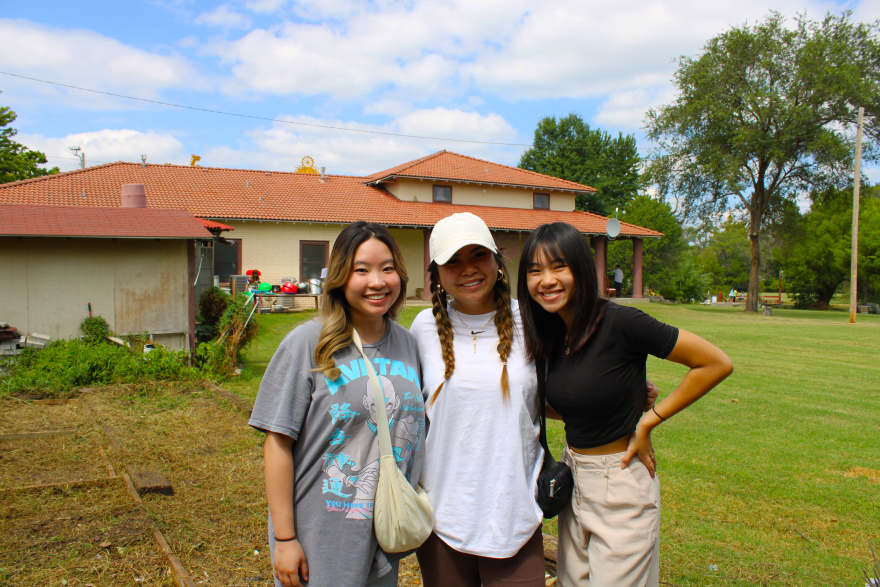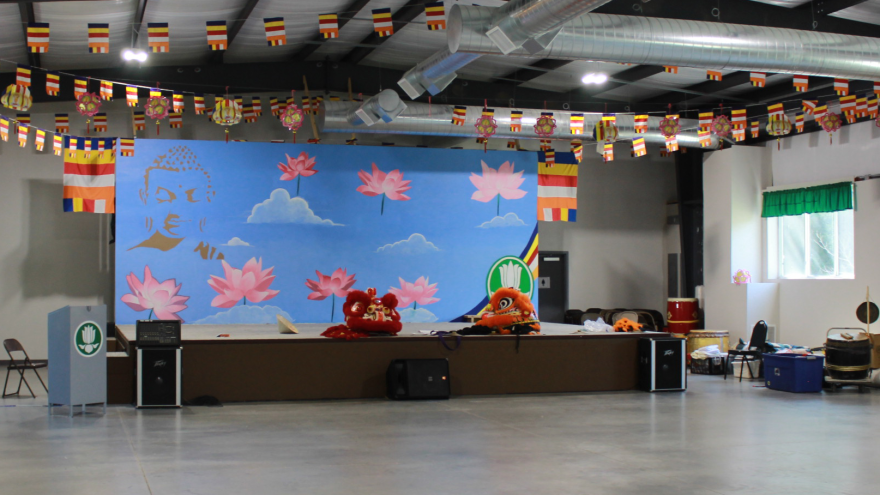Inside the Pháp Hoa Buddhist temple one Sunday morning, 20 grade-schoolers decked out in gray button-down shirts twirl and clap to Vietnamese pop music.
The colorful hall near Arkansas and 53rd Street North is packed with templegoers. Most sit on cushions in front of a large, golden Buddha statue to watch the performance, while some pack into folding chairs in the back of the hall.

Most are here to celebrate Mùa Vu Lan – a Buddhist holiday to honor mothers and fathers. Some kids profess heartfelt gratitude to their parents.
“Thank you mom and dad. I love you mom and dad,” one little girl chirps. “You are the best, mom and dad. Thank you for taking me to temple and taking me to school. … Happy Mùa Vu Lan.”
Buddhism in the city is flourishing as the Asian American population grows and American converts adopt the belief system. The city has more than a dozen Buddhist congregations, according to Gordon Melton, a religion professor at Baylor University who collects data for a national religious census. That’s up from around six in 2000.
That growth is mirrored in national numbers. In the next 40 years, the Buddhist population is projected to grow at a faster rate than the overall North American population, according to Pew Research Center. Melton said the Buddhist population nationally grew 23% from 2010 to 2020.
“Those figures kind of blew me away to see there was that much growth in the community,” Melton said.
The Buddhist religion follows the teachings of a South Asian man known as Buddha, who believed suffering in life could be alleviated through living ethically, mindfully and compassionately.
In Wichita, the community’s growth is apparent — in Pháp Hoa’s crowded hallways on Mùa Vu Lan, in the raucous parade to celebrate a new Laotian meditation hall and in the rented back room of a church, where several Wichitans hold a Buddhist meditation group. It’s also in the quiet halls of the Kansas Meditation Center, a Sri Lankan temple that opened within the last decade.
“Buddhism teaches us to be living in the present moment, how we can make (ourselves happy), how we can give our happiness or share our happiness with others,” said Bhante Ratana, the head monk at the Kansas Meditation Center.
“That is one of the reasons … it’s growing.”
The temples’ origins

Immigrants from Southeast Asian countries founded many of Wichita’s temples, Melton said. That includes Pháp Hoa, which was first established by Vietnamese immigrants in the 1980s.
Temple president Thanh Le’s parents arrived in Wichita after fleeing Vietnam following the fall of Saigon. The Vietnamese community at the time wasn’t very big, Le said.

“They wanted kind of a place to worship,” Le said. “For the people to come to talk together.”
Le said the community could only afford to buy a small church on North Arkansas near 53rd Street, on the very outskirts of the city. The land bordered on rural. That turned out to be perfect for a temple, which needed a peaceful setting.
By the late 1990s, the community started to outgrow the church, reaching around 700 members, Le said. So the Vietnamese community started fundraising to build a new temple across the street.
In the early 2000s, Pháp Hoa opened its main temple — a vibrant, palatial hall with space to meditate, prepare food and make offerings to loved ones who have died.
Carved orange dragons coil around the columns at the temple’s entrance. A smiling white Buddha flanks one side of the building, and potted plants line the paths that wind through the property’s nine acres. A lazy stream spanned by green pedestrian bridges separates the bucolic oasis from the street and the surrounding acres of farmland.
“This place was kind of like a second home to me, growing up,” said 18-year-old templegoer Sandra Le. “People from all different areas come here for it — from the east side, the south side, the north side. … And it's kind of like a big family.”
But the main hall is just one building on the grounds. In 2020, Pháp Hoa built an activity center for a Buddhist youth group. It’s replete with a stage, lion-dancing costumes and instruments.
Keira Le, 17, attended the Pháp Hoa temple as a kid. As she grew up, so did the temple.
“We saw a lot of buildings being built,” Keira said. “For example, the really big, huge activity center. That wasn't there when we were still here during the youth group. And it's just really cool to see — coming back and seeing everything just complete.”

Some of the city’s other temples have also invested in new buildings. The Lao Buddhist Associates of Kansas opened a glistening new meditation hall this month on its grounds near Pawnee and Greenwich. A red and gold meditation chapel opened on the property in 2017.
About a decade ago, several monks came from Laos to lead the temple. Phet Namphengsone said that they’ve brought the temple into its current heyday.
“The monk leadership here has a huge following outside of the state of Kansas,” Namphengsone said. “So if [members] can't be here, they donate money. … So the congregation has grown, as well here in Wichita and outside of Wichita.”
For many, temples act as cultural hubs

On one late summer day at the Lao temple, vendors lined the grounds to sell papaya salad, sticky rice and sugar cane juice. Though the air was laden with humidity and heavy sunlight, a Lao festival was taking place — and the weather was not putting a damper on the festivities.

“We call it nine bouns. Bouns is more like celebrations,” Namphengsone said. “It's nine celebrations over nine days, nine nights.
“You know it’s a Laotian party when you see shoes everywhere,” she added, pointing to the carpet littered with flip-flops and tennis shoes outside the temple.
Two of the festival’s major events included a ribbon cutting for the new meditation hall and 209 monks visiting from across the country to receive offerings. Laotians traveled from Florida, Louisiana, Iowa and Texas for the festival’s parades, dancing, music and food.
“It really, I think, is two things,” Namphengsone said. “The sense of community and networking, as well as feeling like you're contributing to society, right? Because everything that you do out here really should result in good karma for you and your family.”
The Lao Buddhist Associates of Kansas isn’t the only temple serving as a cultural center.
Bhante Ratana opened the Kansas Meditation Center in southeast Wichita in 2012. He became a monk at just 11 years old in his native home of Sri Lanka and traveled to the United States in his 20s to study English. He landed in Oklahoma for school and served as a chaplain in the U.S. Department of Defense.
But he decided to establish the Kansas Meditation Center in Wichita because he saw more interest from the community. He said many Sri Lankans are in Wichita to study at a university in town.
“I think I can provide more services here,” he said. “It’s more than a Buddhist temple. I invite all the practitioners, and we use this place as a Sri Lankan community center.”
The Sri Lankan community in Kansas is not big, but Ratana estimates that holiday celebrations like Buddha’s birthday can draw up to 200 people.
The religion spreads
One of the reasons Ratana was drawn to the U.S., though, is to teach the religion to those who are not culturally Buddhist. He hosts an English-language meditation group in Wichita that’s grown to around 20 people. The group is made up of all ages and races, he said.
“Over here, mainly I see people are very hungry and thirsty about the original teachings of Buddhism, like philosophy,” Ratana said. “So people are more interested in deep teachings. I like it.”
When he served as a military chaplain, Ratana said he traveled around the country teaching meditation techniques to handle stress. In one session, he said, he saw 700 service members.
“They don’t know how to handle their mental difficulties,” Ratana said. “They are looking for something — meditation, mindfulness, teaching how to be here and now. … It is beautiful to see that growing.”

Mindfulness and meditation practice in the U.S. tripled from 2012 to 2017, according to the National Institute of Health. Some Wichitans who did not grow up Buddhist are coming to the religion later in life, with a particular appreciation for these methods.
For Judy McReynolds, meditation meant giving less power to anxious thoughts.
“Being an American, of course, I was brought up in Christianity. But Christianity didn't give me a way to do what I needed to do,” McReynolds said. “And I found that meditation … gave me a way to come out of the suffering.
“I am not who my thoughts are. My thoughts do not run my world. They could be opinions, they could be lies; you lie to yourself, you judge yourself. … And this is a way to look at what they really are, and let them move on.”

McReynolds is part of Southwind Sangha, an English-speaking Buddhist group that meets in a small room in a church near 21st and Oliver. Harold Schlechtweg started leading the group in 2018, after he became ordained as a novice priest. He said language barriers can still be an obstacle in connecting with other temples in town, but that’s starting to change.
The group is also set apart because it practices Zen Buddhism — a different sect than the Vietnamese and Laotian temples.
Despite the differences between temples and sects across the city, though, Bhante Ratana said most have the same goal.
“We have so many different types of sugar — Truvia, brown sugar, white sugar, cane sugar. But what is the taste? The taste is sweet,” Ratana said.
“Same with [Buddhism]. We are coming from different cultures. But our goal is same. Our aim is same. Our aim is getting ultimate happiness. End of our suffering.”
Copyright 2023 KMUW | NPR for Wichita. To see more, visit KMUW | NPR for Wichita. 9(MDA4OTAxNzAzMDEzMjc0MTc2MzA5ZDZlMw004))





















